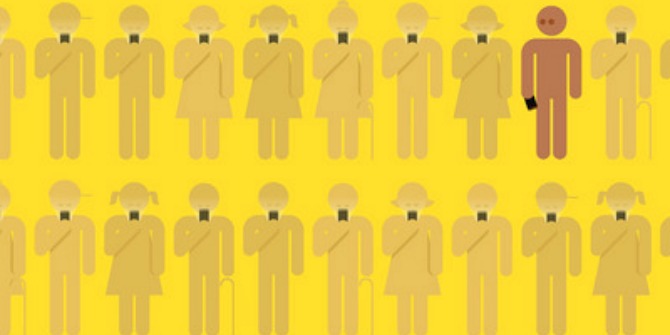In The Crowdsourced Panopticon: Conformity and Control on Social Media, Jeremy Weissman explores the role of ‘peer-to-peer’ surveillance through social media and how this is increasingly shaping our behaviour. This is a welcome addition to the scholarly work on surveillance and privacy, writes Matt Bluemink, with a clear, approachable writing style and a wealth of empirical examples.
The Crowdsourced Panopticon: Conformity and Control on Social Media. Jeremy Weissman. Rowman and Littlefield. 2020.
![]() Find this book (affiliate link):
Find this book (affiliate link): ![]()
In The Crowdsourced Panopticon: Conformity and Control on Social Media, philosopher Jeremy Weissman has taken on one of the most pressing issues affecting contemporary societies: the role of surveillance on social media. As our world becomes increasingly digitised, and more and more of our interactions are mediated through the internet, social media has become an inescapable part of life for billions of people. These technologies exhibit a kind of social power that has never been seen before in history, and Weissman claims that this power has ever growing influence over our behaviour.
In recent years, the mainstream success of academic studies into social media surveillance, such Shoshana Zuboff’s The Age of Surveillance Capitalism, has brought the importance of these issues into the public domain like never before. However, the focus of Weissman’s book is not on the ‘top-down’ surveillance capabilities of tech giants such as Facebook and Google. Instead, he argues that: ‘New ubiquitous information and communication technologies, in particular recording-enabled smart phones and social media programs, are giving rise to a profound new power for ordinary people to monitor and track each other on a global scale’ (83). He shines a light on how this ‘peer-to-peer’ (P2P) surveillance has the power to infiltrate every aspect of our lives, turning us from autonomous individuals into an anonymous ‘public’ in which all individuality has been stamped out through fear of humiliation.
This sounds like a bleak image, but throughout the book Weissman expertly combines empirical studies and philosophical analyses to paint a picture of a world in which our lives are continually broadcast to, and judged by, what Marshall McLuhan called ‘the global village’. In the early chapters Weissman draws on the works of Plato, John Stuart Mill and Eric Fromm to highlight the power of conformity and its negative effects on human action. Whereas much of the literature on surveillance focuses on the power of governments or corporations, Weissman takes a different approach. He reminds us of Mill’s argument that the greatest restrictions on personal liberty do not always come from authoritarian institutions, but from ordinary people — from the public itself.
![]()
Photo by Lianhao Qu on Unsplash
This emphasis on an anonymous, de-individualised public is at the heart of what we might call Weissman’s liberal-existentialist analysis of conformity, which takes him from Mill and Fromm to the philosopher Søren Kierkegaard. Here he brilliantly uses Kierkegaard’s Two Ages (1846) to analyse the existential problems that arise through our engagement with social media. In the digital world, anonymity is a double-edged sword. It frees us from the consequences of our actions, but also forces us to conform to the faceless tyranny of ‘public opinion’.
Kierkegaard argued that the actualised individual must have the power to look inwards and find their true calling — an idea that one is willing to live and die for. But to do this, he insisted we must ‘silence the noise of the external world and the chatter of public opinion’ (45). Only then can we establish ‘an ethical stance despite the whole world’ (47). However, Weissman shows that in the internet age, this is becoming increasingly difficult. The hyper-connectivity that is brought through social media is forcing us to always be ‘on’, always connected, always looking outwards rather than cultivating the inwardness necessary for self-realisation.
Weissman argues that this existential crisis is a fundamentally collective issue. We can only realise ourselves through forming communities with others. But the bonds that are required to form communities cannot be created if we have lost our individuality in a crowd. On this note, one might argue, as Facebook founder Mark Zuckerberg does, that social media inherently brings people together, but Weissman points to a number of studies that highlight increasing detachment people feel from their social media ‘friends’. In essence, the more we expose our lives to others online, the more we are forced to conform to this perceived idea of ‘normality’ which is instilled in us by the anonymous ‘public’:
in a passionless society driven by a detached public opinion behind a screen, instead of a community of separately strong individuals emerging in their shared enthusiastic and even risky determination for a shared passion, what arises is, as Kierkegaard ominously heralds, “a monstrous abstraction, an all-encompassing something that is nothing, a mirage — and this phantom is the public” (53).
This existentialist analysis of social media is perhaps the strongest and most valuable contribution of Weissman’s book. The utilisation of Kierkegaard, a philosopher who experienced first-hand the tyranny of public opinion and a figure who is not automatically associated with privacy studies, certainly makes The Crowdsourced Panopticon stand out from the crowd.
However, in the later chapters, Weissman moves into more familiar territory. The liberal-existentialist analysis of public opinion in the first part of the book sets the stage for the transition from conformity to control. Here, Weissman develops his concept of P2P surveillance through a Foucauldian analysis of power (hence the panopticon in the title). Once again, using a sufficient number of empirical studies to back up his claims, he argues that the nature of social media conformity has led to new methods of control that are not merely operated from a top-down perspective. Instead, each one of us has been put into the jailer’s position at the centre of the panopticon. We are all constantly and anonymously controlling the behaviour of those around us purely through the P2P surveillance that is an inherent part of social media.
Although the chapters on Michel Foucault are well-researched and empirically backed up, there are perhaps too many pages spent going over well-trodden ground. Weissman’s emphasis on P2P surveillance is a welcome addition to the literature, but privacy and surveillance scholars such as David Murakami Wood, David Lyon and Jeffery H. Reiman (among many others) have been utilising Foucault’s analysis of disciplinary power in general, and the panopticon in particular, for many years. Furthermore, considering this section of the book was titled ‘Control’, it may have been beneficial to address Gilles Deleuze’s ‘Postscript on the Societies of Control’, especially given his critique of Foucault and the theoretical parallels to many of the concepts Weissman develops in this section of the book.
Finally, it would have strengthened the book’s argument if the ‘strategies of resistance’ had been expanded beyond the final chapter. The critical literature on surveillance is becoming stronger year on year, but scholars would do well to devote more energy to fleshing out methods of resistance that are adapted to our current technological climate. Nonetheless, these are fairly minor qualms in what is, on the whole, an excellent book. The Crowdsourced Panopticon is a welcome addition to the scholarly work on surveillance and privacy, but the clear, approachable writing style and wealth of empirical examples make it just as accessible to non-experts. Weissman has certainly done his part to increase awareness of how social media affects our behaviour, and has laid the foundations for how we might behave in the future.
Note: This review gives the views of the author, and not the position of the LSE Review of Books blog, or of the London School of Economics and Political Science. The LSE RB blog may receive a small commission if you choose to make a purchase through the above Amazon affiliate link. This is entirely independent of the coverage of the book on LSE Review of Books.






